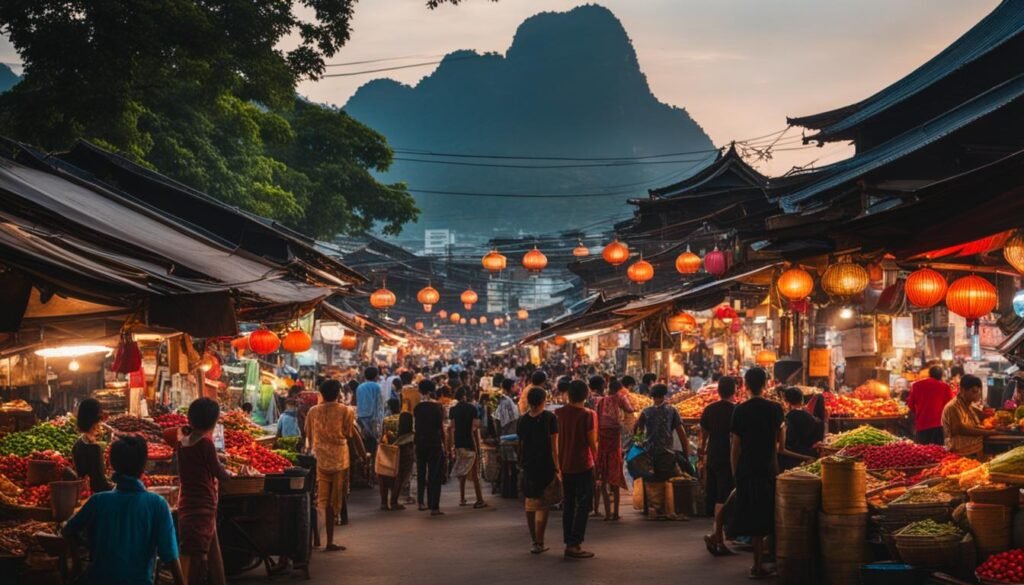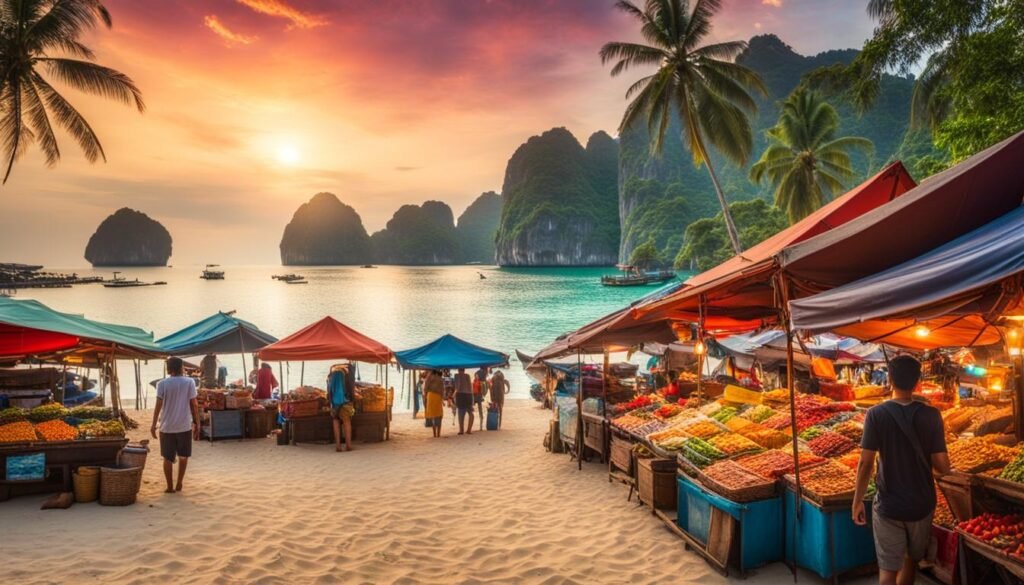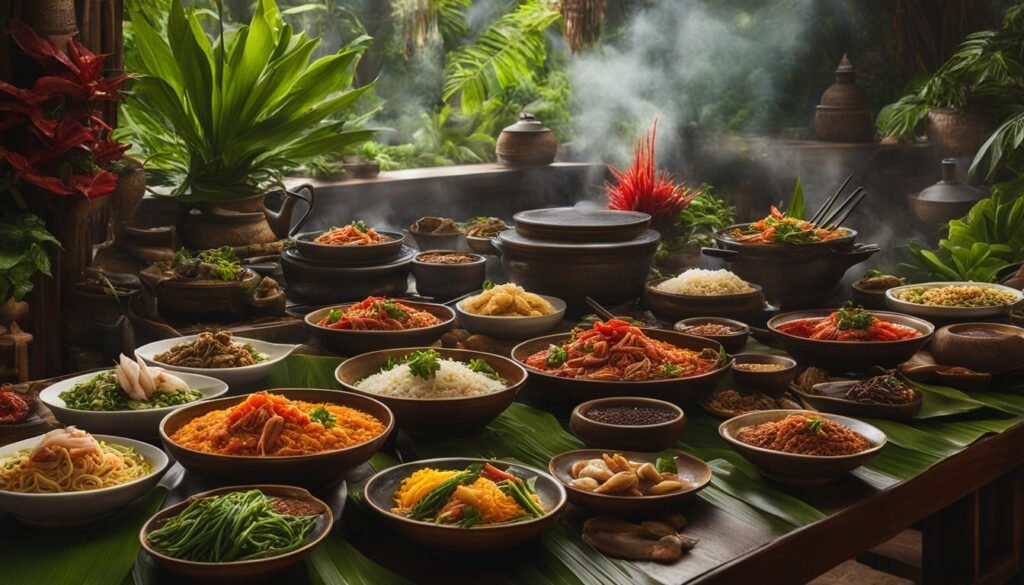South East Asia is a region of diverse cultures, stunning landscapes, and unique experiences. This area of the world is made up of 11 countries, each with its own distinct charm and allure. From the bustling metropolis of Bangkok to the tranquil rice paddies of Bali, South East Asia has something to offer every traveler.
If you’re looking for an adventure, South East Asia is the perfect destination. The region is home to some of the most beautiful beaches, breathtaking natural wonders, and thrilling eco-tourism activities. The warm hospitality of the locals and the rich cultural heritage of each country make South East Asia an unforgettable experience.
Whether you’re interested in exploring ancient temples, trying delicious street food, or immersing yourself in traditional arts and crafts, South East Asia has it all. With so much to discover, it’s no wonder why this vibrant region is a popular destination for travelers from around the world.
Key Takeaways
- South East Asia is made up of 11 countries, each with its own unique charm and allure.
- The region offers a wide range of activities, from thrilling eco-tourism adventures to exploring ancient temples and rich cultural heritage.
- South East Asia is a popular destination for travelers from around the world due to its stunning landscapes, warm hospitality, and diverse cultures.
- Experience the delicious street food, traditional arts, and crafts, and immerse yourself in the cultural heritage of each country in South East Asia.
- From bustling cities to tranquil rice paddies, South East Asia has something to offer every type of traveler.
Understanding the History of Southeast Asia
Embark on a journey through time and discover the rich historical tapestry of South East Asia. From ancient kingdoms to colonial influences, the region’s fascinating history has shaped its diverse culture and vibrant communities.
The earliest kingdoms in the region were the Funan and Chenla Kingdoms, which emerged in Cambodia and Vietnam in the 1st century AD. These early settlements were followed by the Khmer Empire, whose impressive temples, such as Angkor Wat, still stand as a testament to their greatness.
Over the centuries, South East Asia also saw the rise of the powerful Srivijaya and Majapahit empires, which spanned modern-day Indonesia, Malaysia, and Singapore. These empires played a crucial role in shaping the trade routes and cultural exchanges across the region.
In the 16th century, European powers, most notably Portugal and the Netherlands, arrived in South East Asia, bringing with them influences from the Western world. Following this, the region came under colonial rule, with British colonialism dominating Malaysia and Singapore, and French colonialism in Indochina countries like Vietnam and Laos. The region’s colonial past is still evident in architecture, language, and culture.
The 20th century saw the emergence of new nations in South East Asia, with Indonesia, the Philippines, and Singapore becoming independent in the post-World War II era. These nations struggled to find their footing in a rapidly modernizing world, leading to periods of political turbulence and instability.
Today, South East Asian countries have emerged as important players in the global economy, with a rich history and culture that continue to fascinate visitors from around the world.

Immersing in Southeast Asian Culture
South East Asia is a region known for its rich cultural heritage, diverse traditions, and vibrant customs. From ancient practices to modern interpretations, the unique cultures of each country in South East Asia offer a captivating and immersive experience for travelers.
One of the best ways to appreciate the traditions and customs of South East Asia is through the arts. Traditional dances, music, and crafts showcase the unique cultural identity of each country and provide a deep insight into the local way of life.
Traditional Arts in South East Asia
South East Asia is renowned for its rich artistic traditions. Each country has its unique artistic style, from the intricate carvings of Balinese wood craft to the vibrant batik designs of Indonesia.
The traditional dances of South East Asia are another integral part of the region’s cultural heritage. The graceful movements of Thai classical dance, the dynamic energy of Filipino folk dance, and the hypnotic rhythms of the Balinese kecak dance are just a few examples of the diverse dance styles found in the region.
South East Asia is also famous for its exquisite handicrafts, including pottery, weaving, and embroidery. Local markets and artisan villages are great places to find unique and authentic handicrafts that make for memorable souvenirs.
Cultural Festivals
Cultural festivals are an essential part of South East Asia’s vibrant cultural scene. These festivals are often colorful and lively, featuring traditional costumes, music, and dancing. Some of the most popular festivals in the region include:
- Thaipusam in Malaysia and Singapore
- Yi Peng Festival in Thailand
- Hari Raya Aidilfitri in Indonesia, Malaysia, and Singapore
- Songkran in Thailand
- Ati-Atihan Festival in the Philippines
Attending one of these festivals is a once-in-a-lifetime experience that allows you to immerse yourself in the local culture and traditions.
Cultural Etiquette
When exploring the cultures of South East Asia, it’s important to be aware of cultural etiquette. In general, it’s respectful to dress modestly and remove your shoes before entering temples or homes. Some countries also have strict rules about showing respect to the monarchy or religious symbols, so it’s essential to research and understand the local customs before your travels.
By immersing yourself in the arts, attending cultural festivals, and respecting local customs, you can gain a deeper understanding and appreciation of the diverse cultures of South East Asia.
Sampling the Delicious Cuisine of South East Asia
South East Asia is a food lover’s paradise, offering a diverse range of culinary delights that will tantalize your taste buds. From spicy to sweet, sour to savory, the regional cuisine of South East Asia is a treat for your senses.
Regional cuisine Southeast Asia: Each country in South East Asia boasts its unique flavors and dishes, influenced by local traditions, ingredients, and culture. Here are some of the regional specialties you must try:
| Country | Regional Specialties |
|---|---|
| Thailand | Tom Yum Goong (spicy shrimp soup), Pad Thai (stir-fried rice noodles) |
| Vietnam | Pho (noodle soup), Banh Mi (baguette filled with meat and vegetables) |
| Malaysia | Nasi Lemak (coconut rice with spicy sambal), Satay (grilled meat skewers) |
| Indonesia | Nasi Goreng (fried rice), Satay Padang (spicy beef skewers) |
| Philippines | Adobo (meat cooked in vinegar and soy sauce), Lechon (roast pork) |
| Singapore | Chilli Crab (spicy crab dish), Laksa (noodle soup) |
Regional markets and street stalls are a great way to sample local specialties and immerse yourself in the food culture of South East Asia. Don’t be afraid to try new dishes and experiment with different flavors.
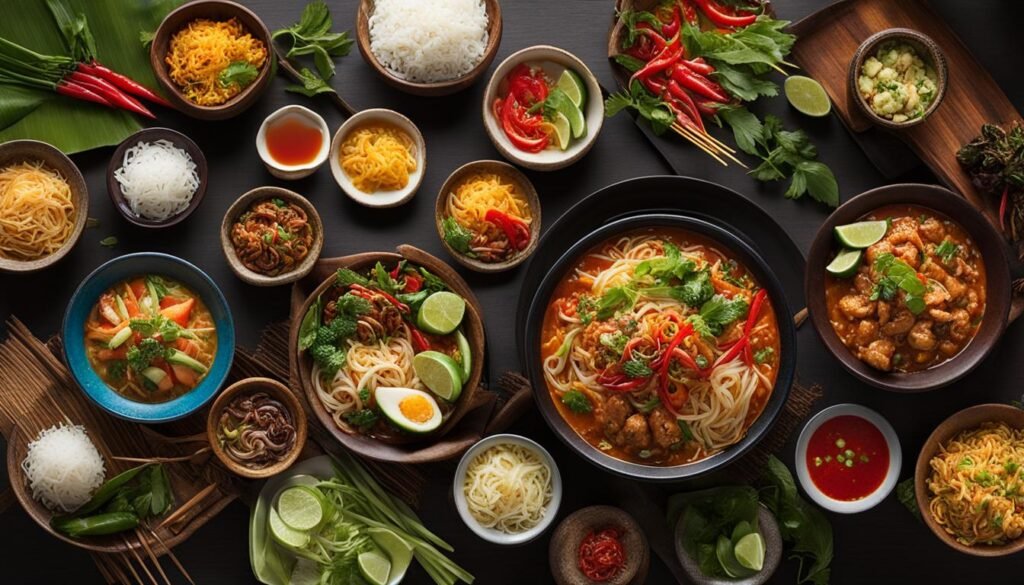
“Food is a central part of South East Asian culture, and each dish tells a unique story about the region’s history, people, and traditions.”
Whether it’s a hearty bowl of Pho in Vietnam or a spicy bowl of Tom Yum Goong in Thailand, South East Asian cuisine is an experience you won’t forget.
Exploring the Natural Wonders of South East Asia
South East Asia is home to some of the most beautiful natural landscapes in the world, from lush jungles to stunning beaches. Whether you’re a nature enthusiast or simply looking for an adventure, exploring the natural wonders of this region is a must-do.
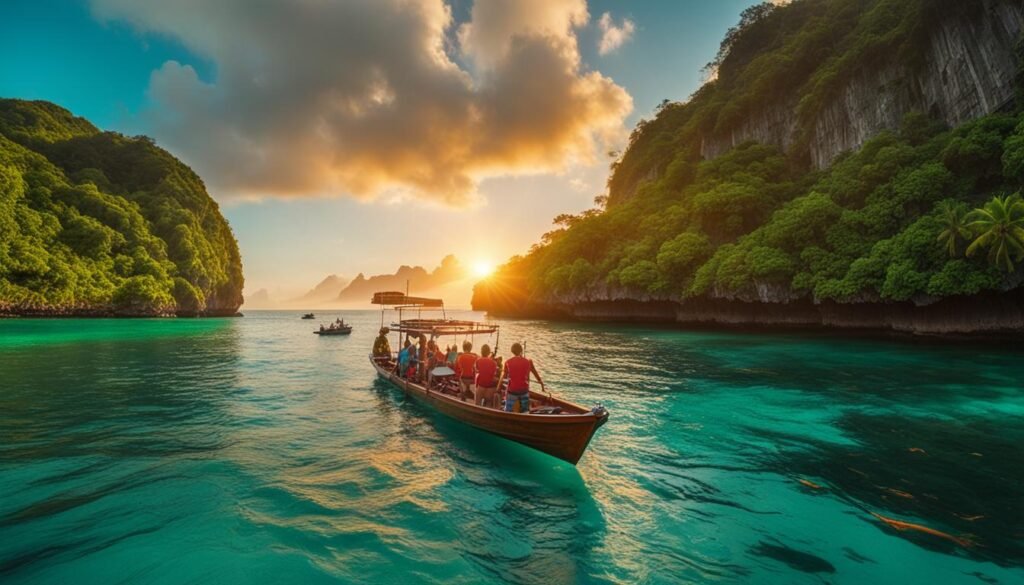
Local Markets and Eco-Tourism
One way to experience the local culture and natural beauty of South East Asia is through visiting its local markets and engaging in eco-tourism activities. From the bustling markets of Bangkok to the serene rice terraces of Bali, each country has its unique offerings. You can immerse yourself in the local culture, try delicious street food, and purchase traditional handicrafts. Eco-tourism activities are also popular, with opportunities for jungle trekking, bird watching, and even volunteering at nature conservation projects.
Sea Adventure Tours
South East Asia boasts a vast array of marine life, and sea adventure tours are a fantastic way to explore the region’s underwater wonders. From diving in the Coral Triangle to snorkeling in the crystal-clear waters of the Philippines, you can witness vibrant coral reefs, tropical fish, and even majestic whale sharks.
| Location | Diving/Snorkeling Highlights |
|---|---|
| Thailand | Similan Islands, Koh Phi Phi, Richelieu Rock |
| Indonesia | Raja Ampat, Komodo National Park, Bali |
| Philippines | Tubbataha Reef, Apo Island, Coron Island |
| Malaysia | Sipadan Island, Mabul Island, Tioman Island |
Whether you’re a beginner or an experienced diver, sea adventure tours in South East Asia offer unforgettable experiences.
Festivals and Celebrations in South East Asia
South East Asia is famous for its vibrant and colorful festivals, which reflect the rich cultural heritage of the region. Celebrations take place throughout the year and are often rooted in ancient traditions and folklore.
One of the most well-known festivals in South East Asia is Songkran , the Thai New Year, which takes place every April. During this festival, people throw water on each other as a symbol of washing away bad luck and welcoming the new year with fresh beginnings. Other popular festivals in Thailand include Loy Krathong , the Festival of Lights, and Yi Peng , the Lantern Festival.
In Malaysia, Diwali is a colorful and lively festival celebrated by the Hindu community, marked by the lighting of oil lamps and fireworks. Thaipusam is another festival unique to Malaysia, where devotees pierce their skin with hooks and spears as a form of penance and purification.
In Indonesia, Galungan is an important Hindu festival that takes place every 210 days. During this time, families prepare offerings and decorations to celebrate the victory of good over evil. In Bali, Nyepi , or the Day of Silence, is also a highly respected festival where locals observe a day of self-reflection and contemplation.
The Philippines has a plethora of festivals, with Sinulog in Cebu and Ati-Atihan in Aklan being some of the most popular. During Sinulog , participants dance in colorful costumes as a tribute to the child Jesus, while Ati-Atihan is a celebration of the Aeta tribe’s culture and traditions.
Finally, Vietnam has the Tet Nguyen Dan , or the Lunar New Year, which falls between late January and February. It is the biggest festival in Vietnam, where families gather to welcome the new year, pay respects to their ancestors, and enjoy traditional foods and customs.
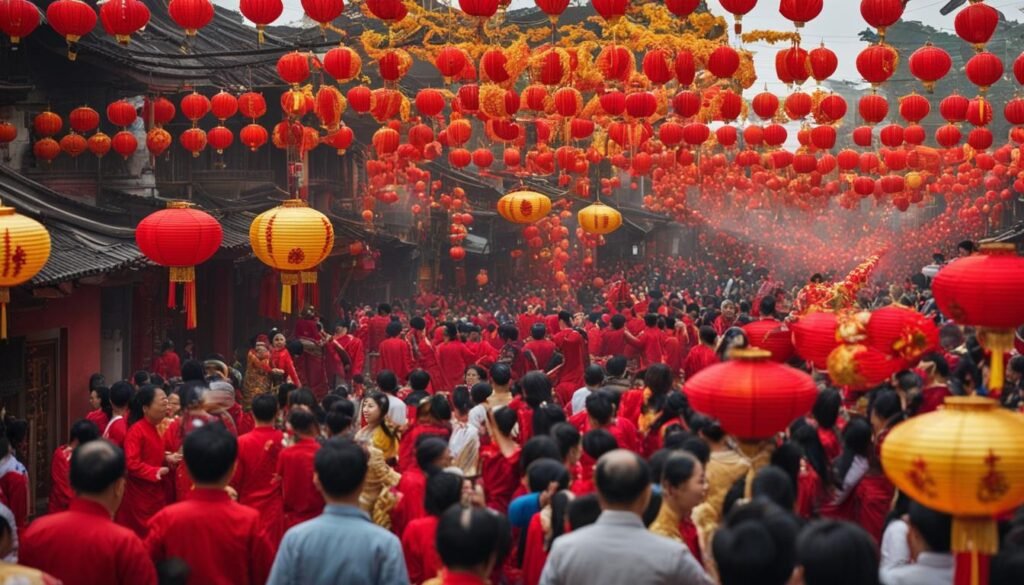
| Country | Festival | Date |
|---|---|---|
| Thailand | Songkran | April |
| Thailand | Loy Krathong | November |
| Thailand | Yi Peng | November |
| Malaysia | Diwali | October/November |
| Malaysia | Thaipusam | January/February |
| Indonesia | Galungan | Every 210 days |
| Indonesia | Nyepi | March/April |
| Philippines | Sinulog | January |
| Philippines | Ati-Atihan | January |
| Vietnam | Tet Nguyen Dan | January/February |
The Languages of South East Asia
South East Asia is a linguistically diverse region, with each country having its own unique language or dialect. Understanding the local language can greatly enhance your travel experience and allow you to connect with the local culture and people.
While English is widely spoken and understood in popular tourist areas, it is important to learn a few key phrases in the local language to show respect and appreciation for the culture.
Major Languages of South East Asia
The major languages spoken in South East Asia include:
| Country | Language |
|---|---|
| Thailand | Thai |
| Vietnam | Vietnamese |
| Indonesia | Bahasa Indonesia |
| Philippines | Tagalog |
| Myanmar | Burmese |
It’s worth noting that in some countries, such as Malaysia and Singapore, English is widely spoken and serves as an official language alongside the local language.
Cultural Significance of Language in South East Asia
Language plays a significant role in South East Asian societies, with many languages closely tied to cultural identity and heritage. In countries like Thailand and Laos, for example, language is considered a form of art, with intricate scripts and tones that make them distinctive and beautiful.
By learning and speaking the local language, you show respect for the culture, which can create a deeper sense of connection between you and the locals.
Whether it’s learning basic greetings or studying the language more extensively, taking the time to understand the local tongue can enrich your travel experience and allow you to appreciate the cultural nuances of South East Asia.

Exploring the Economic Activities in the Asian-Pacific Region
The Asian-Pacific region is home to some of the world’s most rapidly growing economies, with South East Asia playing a significant role in the region’s economic activities. The region has a population of over four billion people, making it one of the largest consumer markets globally.
The countries in South East Asia are rich in natural resources, making them major players in the global commodities market. For instance, Indonesia is the world’s leading producer of palm oil, while Malaysia is the largest exporter of rubber.
South East Asian countries have become attractive investment destinations due to their favorable business environments, abundant resources, and strategic geographical location. The region has been attracting foreign direct investment in various sectors, such as manufacturing, tourism, and technology. As a result, the region’s economies have experienced significant growth, with the GDP of some countries increasing by over 6% annually.
However, the growth of the region’s economies is not without its challenges, particularly on the geopolitical front. Countries in the region are grappling with territorial disputes, trade barriers, and regional power struggles, making geopolitics a critical factor in the region’s economic development.
| Country | GDP (2019, in billions of USD) | Major Industries |
|---|---|---|
| Thailand | 505.98 | Tourism, Automotive, Electronics |
| Indonesia | 1,119.19 | Commodities, Manufacturing, Tourism |
| Philippines | 355.34 | BPO, Manufacturing, Agriculture |
| Malaysia | 364.7 | Petroleum, Electronics, Palm Oil |
| Vietnam | 261.9 | Manufacturing, Agriculture, Mining |
Overall, South East Asia’s economic landscape is a fascinating and dynamic one, offering investors and businesses significant opportunities for growth and expansion. However, it is essential to keep a keen eye on the geopolitical undercurrents that can impact the region’s economies significantly.

Navigating Southeast Asia: Travel Tips and Recommendations
Traveling to South East Asia can be an exciting and enriching experience, but it is essential to be well-prepared to ensure a smooth and enjoyable journey. Here are some travel tips and recommendations to help you navigate the region with ease.
Visa Requirements
Before embarking on your journey, be sure to check the visa requirements for each country you plan to visit. Some countries, such as Thailand and Indonesia, offer visa-free entry for certain nationalities, while others require a visa in advance. You can find information on visa requirements from the embassy or consulate of each country.
Transportation
Getting around South East Asia can be an adventure in itself. While public transportation systems exist in most cities, they can be overcrowded and confusing for newcomers. Taxis and ride-sharing services are widely available in larger cities and can be a more convenient option for travelers. When taking a taxi, make sure to negotiate the fare before getting in.
Accommodations
From budget hostels to luxury resorts, South East Asia offers a wide range of accommodations to suit every budget. When booking your accommodations, be sure to read reviews and check the location for proximity to attractions and transportation. It’s also a good idea to book in advance during the high season to ensure availability.
Southeast Asian Hospitality
One of the most memorable aspects of traveling in South East Asia is the warm hospitality of the local people. From street vendors to hotel staff, the locals are known for their friendliness and willingness to help. Embrace the local culture and customs, and always remember to show respect and gratitude.
Safety
While South East Asia is generally safe for tourists, it’s essential to take precautions to avoid becoming a victim of crime. Be aware of your surroundings and avoid carrying large amounts of cash or wearing expensive jewelry. It’s also important to take care when crossing busy streets and to only use licensed and reputable tour operators for activities such as adventure tours and water sports.

Final Thoughts
With these travel tips and recommendations, you’re well on your way to an unforgettable journey through South East Asia. Enjoy the delicious cuisine, vibrant culture, and natural wonders that this region has to offer, and don’t forget to embrace the warm hospitality of the local people.
Currency Exchange and Money Matters in South East Asia
When traveling to South East Asia, it’s essential to understand the local currencies and the most convenient way to exchange your money. Most countries in the region have their own currencies, and it’s important to know the exchange rates so that you can manage your budget effectively.
The most widely accepted currency for exchange in South East Asia is the US dollar. It’s advisable to carry US dollars in small denominations with you when you travel, as this will make it easier to pay for small purchases and avoid any issues with counterfeit bills. Be aware that many shops and restaurants may not accept credit cards, so it’s best to have cash on hand.
| Country | Currency | Exchange Rate |
|---|---|---|
| Thailand | Thai Baht | 1 USD = 32.98 THB |
| Vietnam | Vietnamese Dong | 1 USD = 23,096.10 VND |
| Indonesia | Indonesian Rupiah | 1 USD = 14,453.44 IDR |
| Philippines | Philippine Peso | 1 USD = 50.54 PHP |
| Malaysia | Malaysian Ringgit | 1 USD = 4.16 MYR |
Note: Exchange rates are subject to change. Please check current rates before your trip.
When it comes to exchanging your money, it’s best to do so at authorized money changers or banks. Be wary of street vendors offering to exchange your money, as they may offer rates that are too good to be true. Additionally, some countries may have restrictions on the amount of foreign currency that can be brought into the country or taken out, so it’s important to check the regulations before you travel.
Overall, managing your money in South East Asia is relatively easy and straightforward, as the cost of living is generally lower than in western countries. However, it’s always a good idea to have a clear understanding of the currency exchange rates and regulations before you embark on your journey.

Unearthing the Hidden Gems of South East Asia
Are you ready to step off the beaten path and discover the hidden gems of South East Asia? From secluded beaches to mystical temples, this vibrant region is teeming with unique experiences waiting to be unearthed.
The Unspoiled Beauty of Laos
Escape the crowds and immerse yourself in the unspoiled beauty of Laos. Explore the magnificent Kuang Si Waterfall, marvel at the intricate carvings of the Pak Ou Caves, and cruise down the Mekong River to witness traditional villages and stunning hillside scenery.

The Majestic Highlands of Malaysia
Travel to the majestic highlands of Malaysia and experience the cool mountain air and breathtaking landscapes. Trek through the lush forests of Cameron Highlands, wander through the tea plantations of the Boh Tea Estate, and immerse yourself in the vibrant culture of the Orang Asli indigenous communities.
The Serene Islands of Indonesia
Discover the serene islands of Indonesia, where crystal-clear waters and pristine beaches await. Snorkel through the vibrant marine life of Bunaken Island, hike to the summit of Mount Rinjani on Lombok Island, and witness the mystical beauty of the Borobudur Temple in Yogyakarta.
The Enchanting Streets of Myanmar
Step into the enchanting streets of Myanmar and explore the unique blend of colonial and Asian architecture. Marvel at the golden Shwedagon Pagoda, wander through the bustling markets of Yangon, and witness the ancient temples and pagodas of Bagan.
As you venture into the hidden gems of South East Asia, you will uncover a rich heritage and culture that is as diverse as it is enchanting. From pristine natural wonders to ancient traditions, this region is waiting to be discovered.
Conclusion
Congratulations on discovering the allure and wonder of South East Asia! We hope we’ve provided you with valuable insights and information that will make your journey through this vibrant region even more exciting and enjoyable.
From the rich cultures and traditions to the stunning landscapes and delicious cuisine, South East Asia offers endless opportunities for exploration and adventure. Whether you’re seeking eco-tourism activities or cultural immersion, there’s something for everyone in these diverse and fascinating countries.
Reflecting On Your Adventures
As you look back on your travels through South East Asia, take a moment to reflect on the memories and lessons learned. Perhaps you discovered a newfound appreciation for the importance of cultural heritage, or maybe you were inspired by the resilience and warmth of the local people.
Whatever the case may be, we hope your experiences in South East Asia have left you with a sense of wonder and appreciation for this incredible region. And who knows? Maybe you’ll be inspired to return and explore even more of the hidden gems and off-the-beaten-path destinations that await.
Safe Travels and Happy Exploring!
As you venture out into the world and continue your travels, remember to stay safe and be mindful of the cultural customs and etiquette of the places you visit. And most importantly, have fun and enjoy the incredible journey that awaits you!
FAQ
What countries make up South East Asia?
South East Asia consists of countries such as Thailand, Vietnam, Malaysia, Indonesia, Singapore, Cambodia, Laos, Myanmar, and the Philippines, among others.
What is the history of South East Asia?
South East Asia has a rich and complex history, with ancient kingdoms, colonial influences, and struggles for independence shaping the region’s development.
What can I expect to experience in terms of culture in South East Asia?
South East Asia is known for its diverse cultures, traditions, and arts. From traditional dances to local crafts, each country offers a unique cultural experience.
What kind of cuisine can I try in South East Asia?
South East Asian cuisine is renowned for its bold flavors and variety. Indulge in dishes such as Thai curries, Vietnamese pho, and Malaysian satay.
What natural wonders can I explore in South East Asia?
South East Asia is home to stunning landscapes, including lush jungles, beautiful beaches, and captivating marine life that can be explored through eco-tourism activities.
Are there any major festivals or celebrations in South East Asia?
Yes, South East Asia is known for its vibrant festivals, such as Thailand’s Songkran Festival and Malaysia’s Diwali celebration, which showcase the region’s cultural diversity.
What languages are spoken in South East Asia?
South East Asia is linguistically diverse, with each country having its own primary language or dialect. Major languages include Thai, Vietnamese, Bahasa Indonesia, and Filipino, among others.
How do economic activities impact South East Asia?
Economic activities play a crucial role in shaping the Asian-Pacific region. Industries, trade relationships, and geopolitical dynamics all influence the economies of South East Asian countries.
What travel tips and recommendations can you provide for exploring South East Asia?
Be prepared with visa requirements, transportation options, and embrace the warm hospitality of the locals while experiencing the diverse countries of South East Asia.
How can I manage currency exchange and money matters in South East Asia?
Understanding local currencies, exchange rates, and following safe financial practices will help you manage your money matters effectively while traveling in South East Asia.
Are there any hidden gems to discover in South East Asia?
Absolutely! Venture off the beaten path to uncover authentic experiences and explore the lesser-known destinations that showcase the unique heritage of each South East Asian country.

